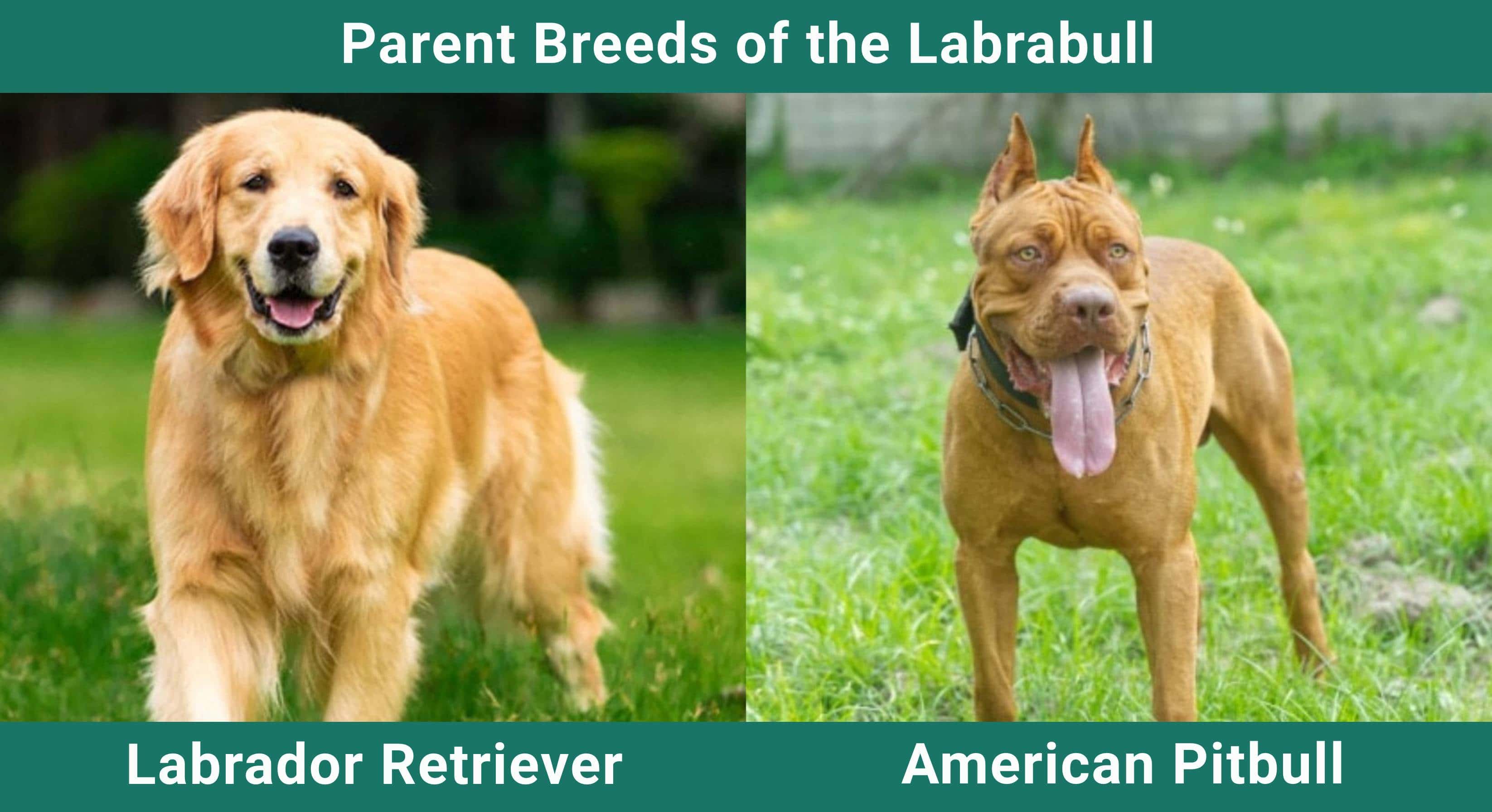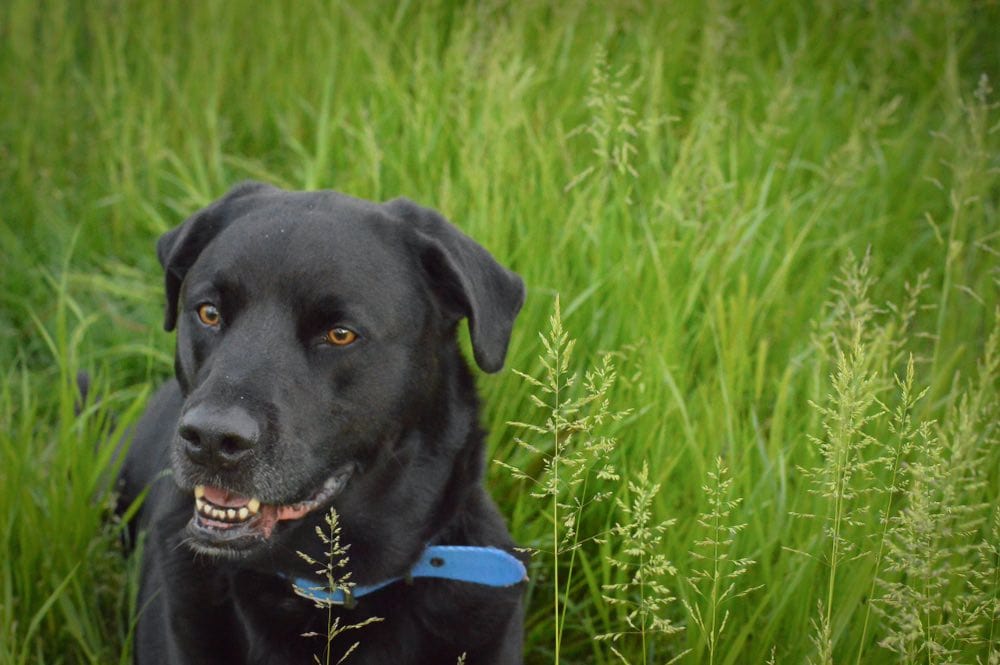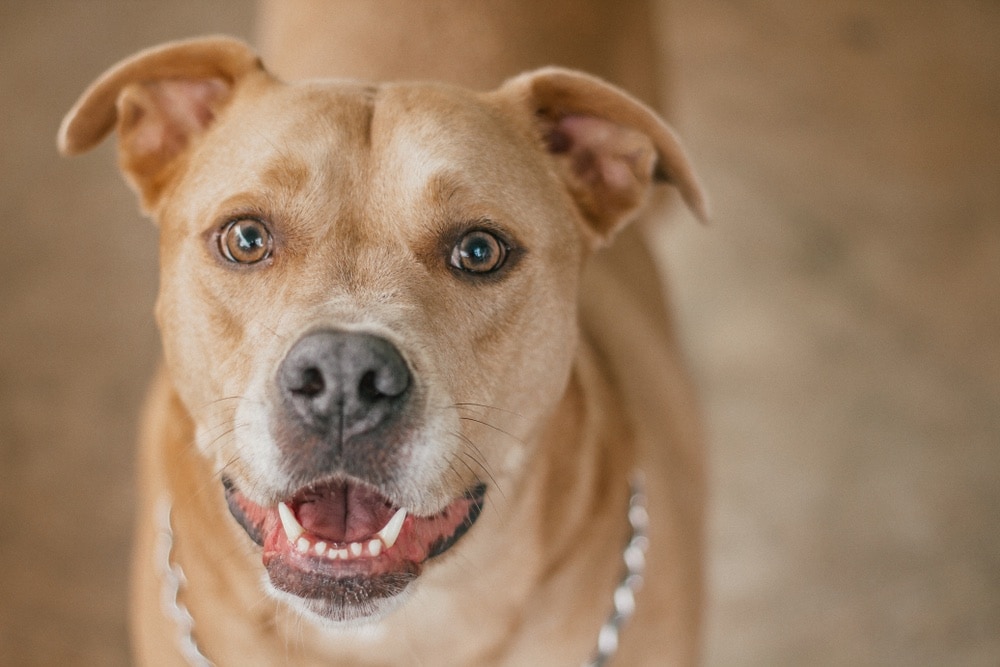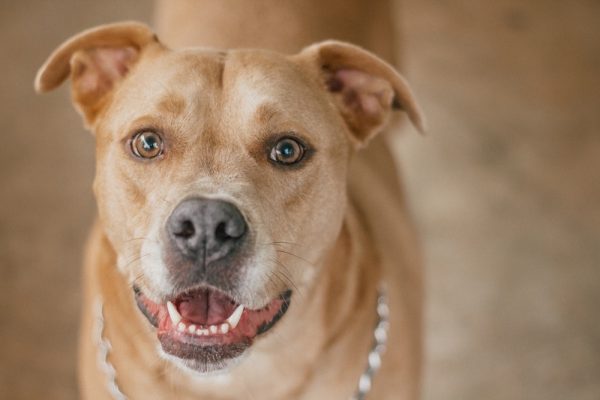Click Below to Skip Ahead
The Labrabull is a hybrid breed, a cross between the family-favorite Labrador Retriever and the infamous American Pitbull. This “designer” breed was created to combine the best traits of both parent breeds, and the result is a playful, friendly, loyal dog that can still be kept as a capable protector if needed. The mix has been largely a success, but this dog is not for everyone, as they are powerful animals that be a bit much for novice owners.
Breed Overview
Height:
20 – 24 inches
Weight:
45 – 95 pounds
Lifespan:
10 – 14 years
Colors:
Black, grey, brown, tan, cream, brindle, silver
Suitable for:
Active families, couples, singles, experienced owners
Temperament:
Intelligent, loyal, protective, energetic, athletic, playful
Labrador Retrievers are the quintessential family dog and one of the most popular dog breeds in the United States due to their friendly nature, intelligence, and gentleness. American Pitbulls have a somewhat formidable reputation due to their strength, power, and their use in dog fights, but in reality, they are gentle, loving dogs that were popular family dogs long before they were ever used for fighting.
The Labrabull is a combination of the best traits of both these breeds, and along with their power and strength, they have a wonderful gentleness and loyalty too. If this sounds like the right mix for you, read on for more information about this beautiful pooch!
Labrabull Puppies
Before bringing home a Labrabull puppy, there are a few important factors to consider. Labradors and Pitbulls are quite different dogs, and the combination can be difficult to imagine. Your Labrabull may inherit most of their temperament from either of their parents, so you need to be prepared for either outcome. An American Pitbull is not a dog for everyone because they need a firm hand in training, while Labs are generally friendly, docile animals. You can never be sure of what combination to expect with a designer breed.
That said, there are important similarities within the two breeds too, as both are loving, affectionate, intelligent, and loyal animals. Also, your dog’s upbringing has a bigger part to play in their personality than the specifics of their breed. Many of the best parts of their personality are determined by their training and socialization. This is apparent in the American Pitbull, a dog that is naturally loyal, friendly, and gentle, but they can also be a formidable fighter and aggressive protector depending on their training and environment.

Temperament & Intelligence of the Labrabull
Labrabulls are typically described by their owners as being loving, loyal, energetic, and playful. Since Pitbulls are such protective animals, you can expect this trait from your Labrabull too, and they are great guard dogs that will not hesitate to protect their families. That said, with this protective nature comes a sensitive side, and these dogs do not do well with harsh training methods. They are social animals that love to be around people and don’t enjoy being left alone for long periods and are generally friendly to everyone they meet.
These dogs have a great deal of energy, and while they enjoy a cuddle on the sofa with their owners, they also need plenty of exercise and mental stimulation to stay happy and healthy. Socialization is vital to their mental health, and although they have the friendly Labrador genetics, they are still powerful animals that need to be adequately socialized to prevent protective behavior. Long play sessions in the dog park can give them both socialization and exercise.
Labrabulls are highly intelligent, and while they are best for experienced owners, training is usually easy because they are so eager to please their owners. They can live happily in an apartment provided that they get enough exercise, but they will be happiest in a home with a large backyard to run around in.
Are These Dogs Good for Families? 👪
Pitbulls have the “nanny dog” history behind them, and Labradors are famously family pooches, so it makes sense that Labrabulls are great family dogs too. These dogs are generally friendly, gentle, and playful and are patient with children and thus, make ideal family dogs. That said, Labrabulls are large, powerful dogs, and when excited, they could easily knock over an unsuspecting child, so you should always exercise caution around small children.

Does This Breed Get Along With Other Pets? 🐶 😽
Labrabulls generally get along great with other dogs because they are gentle and friendly animals. However, they do have Pitbull genetics, meaning they have been developed to be dominant toward other dogs. Usually, the Labrador’s friendliness and good training will overshadow this trait, but it’s good to be aware of it nonetheless. They can get along with other dogs with the right training or even better, if they are raised with other dogs from a young age. Still, they are best suited to a one-dog household.
Labs have a fairly strong prey drive, so smaller animals like cats may be seen as prey, but training and socialization can mitigate this for the most part.
Things to Know When Owning a Labrabull
Food & Diet Requirements 🦴
Labrabulls are large, muscular, and extremely active dogs, and as such, they need a diet that keeps them adequately fueled. A diet high in protein is great, but make sure most of the protein in their food comes from an animal source. An animal-based protein should be in the top three listed ingredients so you can be certain it is responsible for the majority of the protein content. Try to avoid filler ingredients like corn, wheat, and soy because these are largely empty calories that will only serve to cause potential obesity, a real concern with these dogs. Dry food is great, and around 3–4 cups depending on your Labrabull’s size is ideal. It’s also a good idea to add lean meats or wet food occasionally. Lastly, make sure your Labrabull has access to fresh, clean water at all times.
Exercise 🐕
Since these dogs are so full of energy, they’ll need a fair amount of exercise to burn it off. We recommend a minimum of 1 hour a day, but more is better. Without adequate exercise, a Labrabull can quickly develop unwanted behaviors, including excessive chewing, barking, and aggression. They will love long walks, runs, and hikes, and with their Lab heritage, they are sure to love water too. They are also happy to spend hours in the yard playing games with their owners.
Mental stimulation is as important to these intelligent dogs as physical exercise, so make sure to put plenty of mental challenges into their routine. Puzzle toys and games are great, but they’ll love the challenge of agility training or any other active dog sports — and they will excel at them too!
Training 🎾
Labrabulls are intelligent, eager-to-please animals, so training is usually a breeze. That said, they have a history of fighting and aggression, so proper training is essential. Early socialization is key and should begin on the day that you bring them home, along with basic command training. These dogs can be quite a handful for novice owners, and if this is your first dog, we highly recommend going for obedience classes or group training to help the process along.
Labrabulls are sensitive animals, despite their imposing appearance, so they do not do well with harsh training methods. In fact, these methods may only serve to diminish the trust between you and your pooch, something that you do not want to happen with such a powerful animal. Positive reinforcement methods are best and will help forge a bond of trust and loyalty between you and your pooch.
Grooming ✂️
Most Labrabulls inherit the short, coarse hair of their Pitbull parents, so grooming is usually a breeze. They do shed a fair bit, though, so you’ll want to brush them once or twice a week to get rid of any dead hair before it reaches your sofa! They shouldn’t need to be bathed unless they get filthy, but even then, warm water should be enough or you can add a special dog shampoo that won’t disrupt their coat’s natural oils.
You may need to keep an eye underneath their ears for any signs of redness and infections. Try to keep their inner ear dry at all times. Other than that, they’ll need to get their nails clipped every few months and teeth brushed two or three times a week.
Health and Conditions 🏥
Both Labradors and Pitbulls are healthy, robust animals, and since the Labrabull benefits from hybrid vigor — the health benefits inherent in mixed breeds — they are healthy animals overall and suffer from very few health issues due to their varied genetics. Of course, like all dogs, they are susceptible to certain health issues that you should be aware of.
- Allergies
- Obesity
- Skin and ear infections
- Hip and elbow dysplasia
- Bloat
- Hypothyroidism
- Epilepsy
- OCD disorder
Male vs Female
There are notable differences between male and female Labrabulls. Males are generally larger and more muscular than females, sometimes weighing up to 30 pounds more! Females tend to be more independent and less needy than males, and they mature faster than males, making training easier. Males also have more of an aggressive and territorial instinct than females, but this can be largely mitigated with proper training.
Most experts recommend spaying females and neutering males unless of course, you intend on breeding. This will further reduce any hormonal differences, stop unwanted pregnancies in females, and stop males from wandering or marking their territory. It’s important to note that any breed of dog’s temperament is far more influenced by their upbringing and training than their sex.
3 Little-Known Facts About the Labrabulls
1. They make excellent guard dogs.
A Labrador is not the first pooch that comes to mind when you think of a guard dog, and this is because they are more likely to make friends with an intruder than chase them away! However, when the formidable Pitbull is added into the mix, this mixed breed can make excellent guard dogs, even when your Labrabull is more Lab than Pit. Just their appearance alone is usually enough to make would-be intruders think twice!
2. They are highly athletic.
Labrabulls have parent breeds that are iconic in their athleticism. Pitbulls are more muscular than nimble, but with the Lab mixed in, the Labrabull’s intelligence and agility are amazing to watch. These dogs love nothing more than to run, swim, and play with their owner, and they can be trained to do just about anything, from agility to obedience and everything in between.
3. They are sweethearts!
Everybody knows how gentle and sweet Labradors are, and this is one of the reasons that they are such popular family pooches. Pitbulls, on the other hand, do not have the luxury of this reputation. Most people view them as vicious, aggressive animals to steer clear of. This reputation is largely undeserved, though. While it is true that they can be frightening dogs, that’s only when they are trained to be. They are actually sweet and gentle animals that will usually stay far away from a fight when possible. Pitbulls were once known as “nanny dogs” because they were so trustworthy to have around children.
Final Thoughts
The Labrabull is a friendly, affectionate, and playful pooch that makes for a great family dog and a formidable guard dog. They are powerful animals that require consistent training and early socialization to be happy and healthy, without which, you may have an aggressive dog on your hands. With a great deal of time and dedication, they are generally easy to train, but they are still not ideal for novice dog owners.
If you are looking for a dog that can do it all — a great guard dog, an ideal family pooch, and a wonderful exercise partner — the Labrabull is a great choice!
See also:
- Labrador vs Pitbull: The Differences (With Pictures)
- Labrabull (Pitbull & Labrador Mix): Info, Pictures, Care & More!
Featured Image Credit: Josh Chavez, Shutterstock










